
Oakland is a town in and the county seat of Garrett County, Maryland, United States. The population was 1,851 at the 2020 census. It is situated only miles from the source of the Potomac River, which flows directly into Chesapeake Bay. It is also near the Wisp Resort at Deep Creek Lake, a major ski resort for many Marylanders and other visitors. Oakland is part of the Pittsburgh media market.
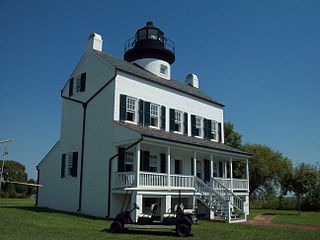
St. Mary's County, established in 1637, is a county located in the U.S. state of Maryland. As of the 2020 census, the population was 113,777. Its county seat is Leonardtown. The name is in honor of Mary, the mother of Jesus. St. Mary's County comprises the California-Lexington Park, Maryland Metropolitan Statistical Area, which also is included in the Washington-Baltimore-Arlington, DC-MD-VA-WV-PA Combined Statistical Area. It is part of the Southern Maryland region. The county was the home to the first Maryland Colony, and the first capital of the Colony of Maryland. Settled by English Catholics, it is considered to be the birthplace of religious freedom in North America, at a time when the British colonies were settled primarily by Protestants. The county is home to the Patuxent River Naval Air Station and St. Mary's College of Maryland. Traditionally, St. Mary's County has been known for its unique and historic culture of Chesapeake Bay tidewater farming, fishing, and crabbing communities. But with the advent of the military bases, growth of an extensive defense contractor presence, and the growth of St. Mary's College of Maryland, as well as increasing numbers of long-distance Washington, D.C. commuters, it has been undergoing a decades-long transformation which has seen the county's population double since 1970.

Lancaster County, sometimes nicknamed the Garden Spot of America or Pennsylvania Dutch Country, is a county in the Commonwealth of Pennsylvania. It is located in the south central part of Pennsylvania. As of the 2020 census, the population was 552,984, making it Pennsylvania's sixth-most populous county. Its county seat is Lancaster. Lancaster County comprises the Lancaster, Pennsylvania metropolitan statistical area.

Bird-in-Hand is an unincorporated community and census-designated place (CDP) in Lancaster County, Pennsylvania, United States, in East Lampeter Township. The "Bird in Hand" ZIP code extends east from the CDP into Leacock and Upper Leacock townships. The community has a large Amish and Mennonite population. As of the 2010 census, the population within the CDP was 402.
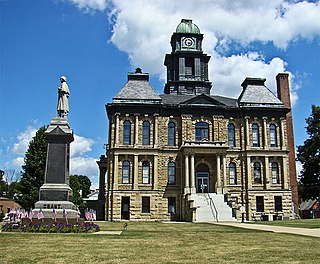
Holmes County is a county in the U.S. state of Ohio. As of the 2020 Census, the population was 44,223. Its county seat is Millersburg. The county was formed in 1824 from portions of Coshocton, Tuscarawas and Wayne counties and organized the following year. It was named after Andrew Holmes, an officer killed in the War of 1812.

Plain people are Christian groups characterized by separation from the world and by simple living, including plain dressing in modest clothing. Many Plain people have an Anabaptist background. These denominations are largely of German, Swiss German and Dutch ancestry, though people of diverse backgrounds have been incorporated into them. Conservative Friends are traditional Quakers who are also considered plain people; they come from a variety of different ethnic backgrounds.
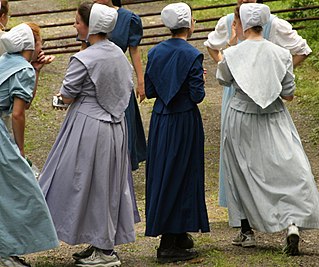
The Old Order River Brethren are a River Brethren denomination of Anabaptist Christianity with roots in the Radical Pietist movement. As their name indicates, they are Old Order Anabaptists.

A horse and buggy or horse and carriage refers to a light, simple, two-person carriage of the late 18th, 19th and early 20th centuries, drawn usually by one or sometimes by two horses. Also called a roadster or a trap, it was made with two wheels in England and the United States. It had a folding or falling top.
The New Order Amish are a subgroup of Amish that split away from the Old Order Amish in the 1960s for a variety of reasons, which included a desire for "clean" youth courting standards, meaning they do not condone the practice of bundling during courtship. Tobacco and alcohol are also not allowed. They also wished to incorporate more evangelical elements into the church, including Sunday school and mission work. Some scholars see the group best characterized as a subgroup of Old Order Amish, despite the name.

Mechanicsville is an unincorporated community and census-designated place in St. Mary's County, Maryland, United States. It is adjacent to the community of Charlotte Hall, which is known for its agriculture, Amish population, large farmers' market/flea market and the Maryland Veterans Home. Mechanicsville has many small businesses and restaurants along Maryland Route 5 and Maryland Route 235. The community is served by the St. Mary's County Public Schools, including Chopticon High School. At the 2010 census, Mechanicsville had a population of 1,528.

Ronks is a small unincorporated farming community and census-designated place (CDP) in East Lampeter Township, Lancaster County, Pennsylvania, United States, just west of Paradise. As of the 2010 census the population was 362.
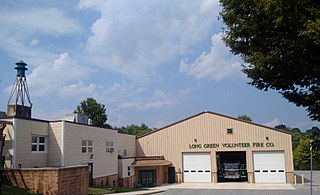
Long Green is an unincorporated community in Baltimore County, Maryland, United States. Until 1958, the community was served by the Maryland and Pennsylvania Railroad at milepost 15.8. Prospect Hill was listed on the National Register of Historic Places in 1973.
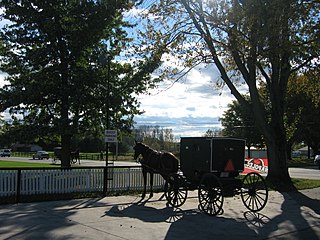
The Groffdale Conference Mennonite Church, also called Wenger Mennonites, is the largest Old Order Mennonite group to use horse-drawn carriages for transportation. Along with the automobile, they reject many modern conveniences, while allowing electricity in their homes and steel-wheeled tractors to till the fields. Initially concentrated in eastern Lancaster County, Pennsylvania, their numbers had grown to 22,305 people resided in eight other states as of 2015. They share the pulpit with the Ontario Mennonite Conference but have some differences in Ordnung.

The Amish, formally the Old Order Amish, are a group of traditionalist Anabaptist Christian church fellowships with Swiss German and Alsatian origins. They are closely related to Mennonite churches, a separate Anabaptist denomination. The Amish are known for simple living, plain dress, Christian pacifism, and slowness to adopt many conveniences of modern technology, with a view neither to interrupt family time, nor replace face-to-face conversations whenever possible, and a view to maintain self-sufficiency. The Amish value rural life, manual labor, humility and Gelassenheit.
Over the years, as Amish churches have divided many times over doctrinal disputes, subgroups have developed. The "Old Order Amish", a conservative faction that withdrew in the 1860s from fellowship with the wider body of Amish, are those that have most emphasized traditional practices and beliefs. There are many different subgroups of Amish with most belonging, in ascending order of conservatism, to the Beachy Amish, New Order, Old Order, or Swartzentruber Amish groups.
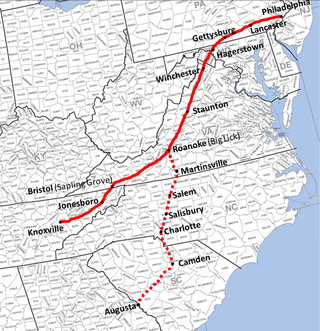
The Shenandoah Valley region of Virginia and parts of West Virginia is home to a long-established German-American community dating to the 17th century. The earliest German settlers to Shenandoah, sometimes known as the Shenandoah Deitsch or the Valley Dutch, were Pennsylvania Dutch migrants who traveled from southeastern Pennsylvania. These German settlers traveled southward along what became known as the Great Wagon Road. They were descendants of German, Swiss, and Alsatian Protestants who began settling in Pennsylvania during the late 1600s. Among them were German Palatines who had fled the Rhineland-Palatinate region of southwestern Germany due to religious and political persecution during repeated invasions by French troops.
Anabaptists and Jews have had interactions for several centuries, since the origins of Anabaptism in the Radical Reformation in early modern Europe. Due to the insularity of many Anabaptist and Jewish communities, Anabaptist–Jewish relations have historically been limited but there are notable examples of interactions between Anabaptists and Jews. Due to some similarities in dress, culture, and language, Amish and Mennonite communities in particular have often been compared and contrasted to Haredi and Hasidic Jewish communities.
The Mennonites in Maryland maintain a small population dating back over a century. The majority of Maryland's Mennonites live in Southern Maryland or on the Eastern Shore, while smaller Mennonite communities exist in Grantsville, Baltimore, Howard County, and elsewhere scattered throughout the state.

The Ohio Amish Country, also known simply as the Amish Country, is the second-largest community of Amish in the world, with in 2023 an estimated 84,065 members according to the Young Center for Anabaptist and Pietist Studies at Elizabethtown College. Ohio's largest Amish settlement is centered around Holmes County and in 2023 included an estimated 39,525 children and adults, the second largest in the world and the highest concentration of Amish in any US county; the Amish make up half the population of Holmes County, with members of other closely related Anabaptist Christian denominations, such as the Mennonites, residing there as well. The second largest community in Ohio is centered around Geauga County.


















